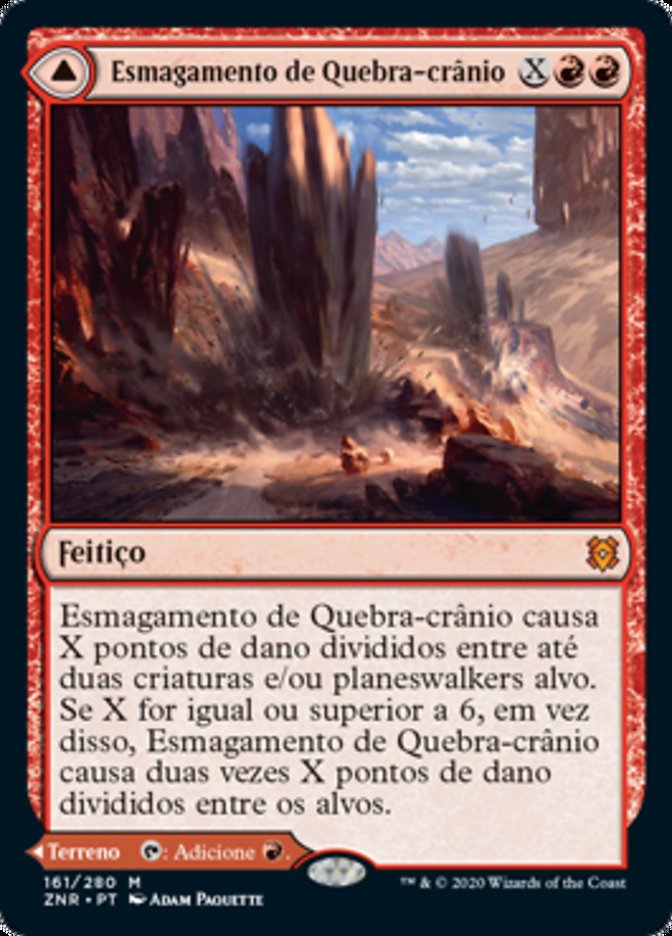

Esmagamento de Quebra-crânio {X}{R}{R}
Feitiço
Esmagamento de Quebra-crânio causa X pontos de dano divididos entre até duas criaturas e/ou planeswalkers alvo. Se X for igual ou superior a 6, em vez disso, Esmagamento de Quebra-crânio causa duas vezes X pontos de dano divididos entre os alvos.
Terreno
{T}: Adicione {R}.
Quebra-crânio, o Passo do Martelo
Terreno
Conforme Quebra-crânio, o Passo do Martelo, entra no campo de batalha, você pode pagar 3 pontos de vida. Se não fizer isso, ele entrará no campo de batalha virado.
{T}: Adicione {R}.
Feitiço
{X}{R}{R}
“O jeito mais seguro de cruzar as Presas Celestes é voando. O Passo de Quebra-crânio é o segundo, mas bem de longe.”
— Samila, Casa Expedicionária de Murasa
Illustrated by Adam Paquette
- Standard
- Not Legal
- Alchemy
- Not Legal
- Pioneer
- Legal
- Explorer
- Legal
- Modern
- Legal
- Historic
- Legal
- Legacy
- Legal
- Brawl
- Legal
- Vintage
- Legal
- Timeless
- Legal
- Commander
- Legal
- Pauper
- Not Legal
- Oathbreaker
- Legal
- Penny
- Not Legal
Toolbox
Buy This Card
Notes and Rules Information for Esmagamento de Quebra-crânio // Quebra-crânio, o Passo do Martelo:
- Only the English version of a Magic card receives Oracle updates and errata. View this card in English. (Scryfall note)
- You divide the damage as you cast Shatterskull Smashing, not as it resolves. If you choose two targets, each target must be assigned at least 1 damage. (2020-09-25)
- If X is 6 or more, you divide twice X damage; you don’t assign X damage and then double that damage. (2020-09-25)
- If one of the targets becomes illegal for Shatterskull Smashing, the original division of damage still applies to the still-legal target, but the damage that would have been dealt to the illegal target isn’t dealt at all. (2020-09-25)
- There is a single triangle icon in the top left corner of the front face. There is a double triangle icon in the top left corner of the back face. (2020-09-25)
- To determine whether it is legal to play a modal double-faced card, consider only the characteristics of the face you’re playing and ignore the other face’s characteristics. (2020-09-25)
- If an effect allows you to play a specific modal double-faced card, you may cast it as a spell or play it as a land, as determined by which face you choose to play. If an effect allows you to cast (rather than “play”) a specific modal double-faced card, you can’t play it as a land. (2020-09-25)
- If an effect allows you to play a land or cast a spell from among a group of cards, you may play or cast a modal double-faced card with any face that fits the criteria of that effect. (2020-09-25)
- The converted mana cost of a modal double-faced card is based on the characteristics of the face that’s being considered. On the stack and battlefield, consider whichever face is up. In all other zones, consider only the front face. This is different than how the converted mana cost of a transforming double-faced card is determined. (2020-09-25)
- A modal double-faced card can’t be transformed or be put onto the battlefield transformed. Ignore any instruction to transform a modal double-faced card or to put one onto the battlefield transformed. (2020-09-25)
- If an effect puts a double-faced card onto the battlefield, it enters with its front face up. If that front face can’t be put onto the battlefield, it doesn’t enter the battlefield. (2020-09-25)
- If an effect instructs a player to choose a card name, the name of either face may be chosen. If that effect or a linked ability refers to a spell with the chosen name being cast and/or a land with the chosen name being played, it considers only the chosen name, not the other face’s name. (2020-09-25)
- In the Commander variant, a double-faced card’s color identity is determined by the mana costs and mana symbols in the rules text of both faces combined. If either face has a color indicator or basic land type, those are also considered. (2020-09-25)